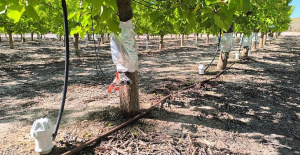MADRID, 25 Ago. (EUROPA PRESS) -
Agriculture generated more than 1.2 million contracts during the first half of the year, of which 74.2% correspond to fixed-term contracts (926,790) and 25.8% to indefinite contracts (321,848), according to It follows from the data analyzed by the human resources company Randstad.
Specifically, the report shows that the volume this year is 14.5% lower than that of the first six months of 2021, although the indefinite ones soared in the current one, multiplying approximately by five.
In fact, in 2021, permanent contracts barely accounted for 4.3%, while they currently represent 25.8%.
The director of Randstad Research, Valentín Bote, has explained these records. "These figures indicate not only the importance of the primary sector in our economy, but also that it is a consequence of the entry into force of the labor reform, since the total number of contracts has been reduced by the new formulas and by the dynamic of indefinite contracts introduced by the new regulations", he pointed out.
After reviewing the historical series of the last ten years, it is verified that, despite the impact of the labor reform, the reduction in the total volume of firms with respect to the semester of 2021 is a habitual trend in the sector.
After two years, 2012 and 2013, in which this indicator remained just above 840,000 headings, the volume exceeded 1.2 million in 2014, 1.5 in 2017, and 1.6 in 2019.
With the outbreak of the pandemic, the number of contracts fluctuated between 1.4 million contracts in the last two years, to fall to the current 1.2 million signatures.
By region, Andalusia is, by far, the Community with the highest volume of contracting in agriculture, with 666,309 signatures, which represents 53.4% of the total signed throughout the country during the first semester.
It is followed, at a distance, by the Region of Murcia (198,263), Extremadura (95,550), the Valencian Community (89,501) and Castilla-La Mancha (62,895), while with more moderate figures are Catalonia (29,494), Aragón (28,256 ), Castilla y León (19,772), La Rioja (12,854) and Galicia (12,716).
Below 10,000 signatures are Navarra (9,488), the Canary Islands (7,766), Euskadi (5,961), the Community of Madrid (4,752), the Balearic Islands (1,961), Asturias (1,625) and Cantabria (1,157).
At the provincial level, those with the highest volumes were Huelva (158,723), Jaén (130,154), Córdoba (102,577), Seville (97,917), Badajoz (74,178), Granada (71,566) and Valencia (55,607).
Regarding variations with respect to the first half of 2021, the study highlights that the Canary Islands (14.3%) and the Basque Country (3%) were the only regions to experience growth in their contracting volumes in the agricultural sector.
Already registering falls, although moderate, are the Balearic Islands (-3%), Asturias (-3.6%), Navarra (-3.9%), La Rioja (4%), Galicia (-6.2%) and Castila and León (-7.3%), while the most pronounced decreases, although still below the national average (-14.5%), occurred in the Community of Madrid (10%), the Valencian Community ( 11.1%), Andalusia (-11.4%), Castilla-La Mancha (-13.6%) and Catalonia (-14.2%).
For its part, the greatest decreases took place in Extremadura (-16.1%), Cantabria (-19.7%), Aragón (-25.4%) and the Region of Murcia (-26%).
On the other hand, the report shows that half of the contracts were signed by workers between 25 and 45 years old, while by sex, 73% of the signatures correspond to men and only 27% to women.
Regarding the age of contract signatories in this sector during the summer, nearly half (49.1%) are between 25 and 45 years old, followed by those over 45 (36.8%) and those under of 25 (14.1%).
The greatest drop in hiring occurred in the segment of professionals aged between 25 and 45 years, while the decrease was 12% between those over 45 and those under 25.

 Exploring Cardano: Inner Workings and Advantages of this Cryptocurrency
Exploring Cardano: Inner Workings and Advantages of this Cryptocurrency Seville.- Economy.- Innova.- STSA inaugurates its new painting and sealing hangar in San Pablo, for 18 million
Seville.- Economy.- Innova.- STSA inaugurates its new painting and sealing hangar in San Pablo, for 18 million Innova.- More than 300 volunteers join the Andalucía Compromiso Digital network in one month to facilitate access to ICT
Innova.- More than 300 volunteers join the Andalucía Compromiso Digital network in one month to facilitate access to ICT Innova.-AMP.- Ayesa acquires 51% of Sadiel, which will create new technological engineering products and expand markets
Innova.-AMP.- Ayesa acquires 51% of Sadiel, which will create new technological engineering products and expand markets Madrid celebrates its patron's day with the absence of Más Madrid from the medal ceremony because it "whitewashes" Israel
Madrid celebrates its patron's day with the absence of Más Madrid from the medal ceremony because it "whitewashes" Israel The Ibex 35 wakes up with an increase of 0.34% and clings to 11,200, waiting for the US CPI.
The Ibex 35 wakes up with an increase of 0.34% and clings to 11,200, waiting for the US CPI. STATEMENT: Oxehealth receives regulatory authorizations for sleep monitoring in mental health
STATEMENT: Oxehealth receives regulatory authorizations for sleep monitoring in mental health STATEMENT: Sigenergy presents the innovative SigenStor C solution
STATEMENT: Sigenergy presents the innovative SigenStor C solution How Blockchain in being used to shape the future
How Blockchain in being used to shape the future Not just BTC and ETH: Here Are Some More Interesting Coins Worth Focusing on
Not just BTC and ETH: Here Are Some More Interesting Coins Worth Focusing on The CSN finances an IFIC project to evaluate a technology that improves nuclear waste management
The CSN finances an IFIC project to evaluate a technology that improves nuclear waste management Expociència expects to receive more than 4,000 visitors in the Science Park of the University of Valencia
Expociència expects to receive more than 4,000 visitors in the Science Park of the University of Valencia They develop devices for the precise diagnosis of cancer patients
They develop devices for the precise diagnosis of cancer patients UMH researchers are working on a high-quality apricot crop that requires less irrigation water
UMH researchers are working on a high-quality apricot crop that requires less irrigation water A million people demonstrate in France against Macron's pension reform
A million people demonstrate in France against Macron's pension reform Russia launches several missiles against "critical infrastructure" in the city of Zaporizhia
Russia launches several missiles against "critical infrastructure" in the city of Zaporizhia A "procession" remembers the dead of the Calabria shipwreck as bodies continue to wash up on the shore
A "procession" remembers the dead of the Calabria shipwreck as bodies continue to wash up on the shore Prison sentences handed down for three prominent Hong Kong pro-democracy activists
Prison sentences handed down for three prominent Hong Kong pro-democracy activists ETH continues to leave trading platforms, Ethereum balance on exchanges lowest in 3 years
ETH continues to leave trading platforms, Ethereum balance on exchanges lowest in 3 years Investors invest $450 million in Consensys, Ethereum incubator now valued at $7 billion
Investors invest $450 million in Consensys, Ethereum incubator now valued at $7 billion Alchemy Integrates Ethereum L2 Product Starknet to Enhance Web3 Scalability at a Price 100x Lower Than L1 Fees
Alchemy Integrates Ethereum L2 Product Starknet to Enhance Web3 Scalability at a Price 100x Lower Than L1 Fees Mining Report: Bitcoin's Electricity Consumption Declines by 25% in Q1 2022
Mining Report: Bitcoin's Electricity Consumption Declines by 25% in Q1 2022 Oil-to-Bitcoin Mining Firm Crusoe Energy Systems Raised $505 Million
Oil-to-Bitcoin Mining Firm Crusoe Energy Systems Raised $505 Million Microbt reveals the latest Bitcoin mining rigs -- Machines produce up to 126 TH/s with custom 5nm chip design
Microbt reveals the latest Bitcoin mining rigs -- Machines produce up to 126 TH/s with custom 5nm chip design Bitcoin's Mining Difficulty Hits a Lifetime High, With More Than 90% of BTC Supply Issued
Bitcoin's Mining Difficulty Hits a Lifetime High, With More Than 90% of BTC Supply Issued The Biggest Movers are Near, EOS, and RUNE during Friday's Selloff
The Biggest Movers are Near, EOS, and RUNE during Friday's Selloff Global Markets Spooked by a Hawkish Fed and Covid, Stocks and Crypto Gain After Musk Buys Twitter
Global Markets Spooked by a Hawkish Fed and Covid, Stocks and Crypto Gain After Musk Buys Twitter Bitso to offset carbon emissions from the Trading Platform's ERC20, ETH, and BTC Transactions
Bitso to offset carbon emissions from the Trading Platform's ERC20, ETH, and BTC Transactions Draftkings Announces 2022 College Hoops NFT Selection for March Madness
Draftkings Announces 2022 College Hoops NFT Selection for March Madness



























